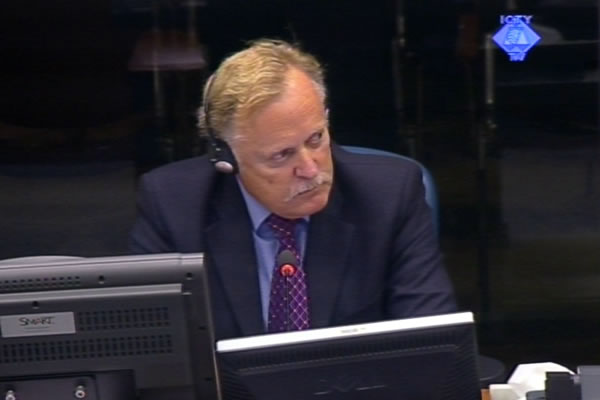Home
LEGITIMATE MILITARY TARGETS IN SARAJEVO
British lieutenant colonel Richard Mole was cross-examined by Mladic’s defense. He confirmed that the mobile mortars and tanks in Sarajevo were legitimate targets. He did add a caveat: only immediate response to their fire could be ‘effective’. Whatever the side under attack did in such a ‘frustrating situation’, it was bound to be wrong
 Richard Mol, witness at the Ratko Mladic trial
Richard Mol, witness at the Ratko Mladic trial In the cross-examination of British lieutenant colonel Richard Mole, Ratko Mladic's defense counsel tried to justify the shelling of Sarajevo by the VRS in late 1992, when Mole served as senior UN military observer in Sarajevo.
Defense counsel Ivetic referred back to the witness's statement from 1997 to argue that the BH Army in Sarajevo targeted Bosnian Serb positions using mobile mortars. This, the defense argued, rendered the positions from which fire was opened legitimate military targets and the Sarajevo-Romanija Corps could respond and neutralize the source of fire. Mole agreed with the defense, but with a caveat that only immediate response to fire could be 'effective'. Mobile mortars would be moved away from the position where they had been fired and fire could not be returned immediately because this was not ‘a game of table tennis’.
In his reply to a hypothetical question asked by the presiding judge, Mole said that 'movement' of mortars could result in the rounds falling short of the target, hitting the BH Army-controlled territory instead of the enemy positions.
The defense counsel brought up the witness's statement that the Bosnian Serbs put the pressure on Sarajevo and that the 'Presidency forces' used the situation in the city to 'reinforce the image of the victim even when they were responsible for the attacks'. Mole confirmed that the BH Army deployed artillery near the Kosevo Hospital and other civilian facilities. According to the witness, this 'was a direct provocation' to the Serbs to attack. These weapons were a legitimate military target even if they weren’t used, Mole said.
Mole also confirmed that the BH Army 1st Corps had about 70,000 soldiers, half of whom were deployed in Sarajevo. Soldiers were often stationed in schools and other civilian buildings; this rendered such buildings legitimate military targets, in Mole's opinion.
At the end of the cross-examination the defense counsel showed the witness a series of reports of the Sarajevo-Romanija Corps about their response to the BH Army attacks from Mount Igman. The response was 'militarily legitimate and justified', the witness confirmed.
In the re-examination, Mole noted that targeting mobile mortars with artillery 'is not the best response' because the mortars 'were probably moved elsewhere' and the artillery rounds could cause civilian casualties. When the presiding judge suggested that in such situations the response of the side under attack was 'always wrong' the witness smiled and said that it was an extremely frustrating situation. 'It is like trying to crack hazelnuts with a hammer'.
Linked Reports
- Case : Mladic
- 2012-11-01 BLOCKING SARAJEVO TO ACHIEVE OBJECTIVES IN OTHER BATTLEFIELDS
- 2012-10-31 CHILDREN MASSACRED WHILE PLAYING IN THE SNOW
- 2012-10-29 TOO YOUNG TO SERVE IN THE ARMY, OLD ENOUGH TO KILL
- 2012-11-05 ISMET SVRAKA TESTIFIES FOR THE SECOND TIME AT THE TRIBUNAL
- 2012-11-06 VRS INSIDER GIVES EVIDENCE
- 2012-11-07 STRICT LINE OF COMMAND WITH MLADIC ON TOP
